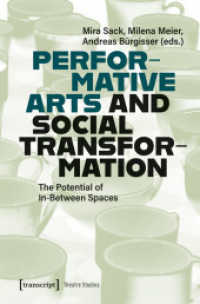- ホーム
- > 洋書
- > 英文書
- > Science / Mathematics
Full Description
Through the lens of critical thinking and creative analogy, this book skillfully blends mainstream perspectives with bold, thought-provoking personal insights, offering readers a fresh and engaging perspective on complex topics. By leveraging critical thinking, creative analogies, and practical examples from statistics, medicine, socioeconomics, education, and technology, it bridges the gap between abstract theory and real-world applications.
Each chapter is concise and impactful, cutting straight to the essence of the subject. Thought experiments and vivid examples illuminate key concepts, making them both accessible and actionable. Whether you're seeking clarity, inspiration, or a deeper understanding, this book delivers powerful, thought-provoking content that will leave a lasting impression.
Key Features:
A harmonious balance of mainstream views and provocative personal insights
Creative analogies paired with practical examples from medicine and other fields
Concise, clear, and practical chapters that focus on core ideas, enriched with thought experiments and real-world applications
A progressive approach, moving from simple daily decision-making to the development of integrated, humanized AI
Chapter exercises designed to reinforce concepts through hands-on practice
Contents
Chapter 01 Inventive Connections: A Journey Through Analogies
Chapter 02 The Golden Point for Decision-Making
Chapter 03 The Art of Randomization
Chapter 04 An Anti-Polarization Political System Inspired by the Play-the-Winner Strategy
Chapter 05 Clinical Trial Design and Development: Insights from Game Theory and Stochastic Processes
Chapter 06 Enhancing Productivity and Economic Growth Through Paradoxical Insights
Chapter 07 Identifying Biases via Critical Thinking
Chapter 08 Interesting Yet Challenging in Statistical Modeling
Chapter 09 Dimensional Analysis Assisted Statistical Modeling
Chapter 10 Recursive Functions as Self-Referencing Analogies
Chapter 11 Creative Data Visualization
Chapter 12 From Brownian Motion to Unified Models: Bridging Scales and Disciplines
Chapter 13 Quantum Computing Explained via Analogies
Chapter 14 Dual Forces: Evolution, Devolution, and Feedback Systems
Chapter 15 What Constitutes Science and Scientific Evidence?
Chapter 16 The Similarity Principle
Chapter 17 iWordnet and the Connotation of Understanding
Chapter 18 Analogy in Artificial Intelligence
Chapter 19 Analogy-Made Humanized AI
Chapter 20 Education Shifts and Futuristic Society in the AI Age






